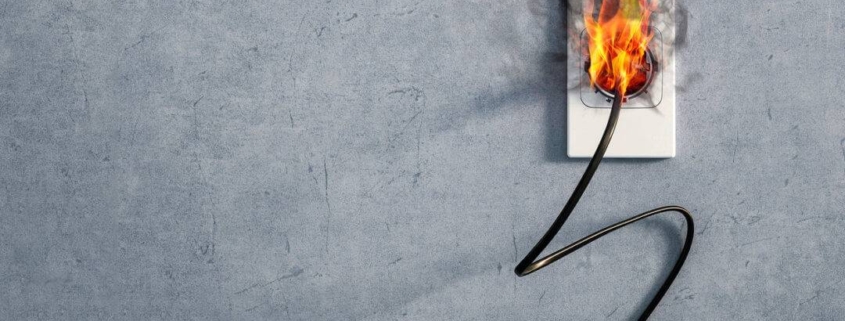How To Put Out An Electrical Fire—And Prevent One
House Fires Caused By Electricity Often Cause More Damage
With the holiday season upon us, we wanted to bring you a few safety tips on keeping your home safe while displaying holiday lights and decorations. According to the U.S. Fire Administration (USFA), there were about 24,000 electricity-caused residential fires reported each year between 2014 and 2016. And electrical malfunctions accounted for 6.8% of all residential fires in 2018. Compared to fires caused by cooking and heating equipment, this seems like a small number.
However, electrical home fires cause, on average, over twice the monetary damage ($27,500 vs. $12,510 per fire) of non-electrical fires. They also cause more injuries (26.6 vs. 22.8 per 1,000 fires) and deaths (6.3 vs. 3.4 per 1,000 fires) than non-electrical fires.
It’s important to learn how to prevent electrical fires and how to react if one happens. In this article, we discuss:
- Where and why electrical fires start
- Tips to prevent electrical fires
- How to safely extinguish an electrical fire
Don’t forget that working smoke detectors or smoke and heat sensors save lives. When these devices are present and properly maintained, they give you and yours precious time to react and escape in the event of a fire, whatever the cause.
How Does Electricity Cause House Fires?
According to the USFA, home electrical fires usually start in occupied parts of a house, with 15.4% igniting in the bedroom, 7.4% in the cooking area, and 6.7% in the living area. This makes sense; we use our electronics in these places. However, many electrical fires also start in inaccessible or rarely-visited locations—8.7% start inside wall spaces, and 13% start in the attic. This data matches up with the materials that ignite first in home electrical fires, which are:
- “Electrical wire, cable insulation” (30.9%)
- “Structural member or framing” (17.8%)
- “Thermal, acoustic insulation within wall, partition, or floor/ceiling” (7.2%)
- “Interior wall covering” (5.5%)
- “Exterior sidewall covering, surface, finish” (6.2%)
But what causes these fires to ignite? The USFA reports that heat from powered equipment ignited 87.8% of electrical fires between 2014 and 2016. Within that category, electrical arcing ignited the most fires (74%). The most common (87.8%) factor contributing to the ignition of home electrical fires was general electrical failure or malfunction. Excluding non-specified malfunctions, the most common type of malfunction leading to ignition was, again, electrical arcing from a short circuit (34%).
Bad practices also result in fires. “Misuse of material or product” caused 5.5% of fires, “design, manufacture, installation deficiency” caused 1.2%, and “operational deficiency” caused 4.5%.
How To Prevent Electrical House Fires
To prevent home electrical fires, prevent your electronics from generating sparks or too much heat. In practice, this means caring for your electronics so that you don’t overload your circuits, and the electricity stays where it should. To do this, it helps to understand a bit about how your home’s electrical system works.
Multiple branch circuits distribute electricity throughout your house. For instance, you likely have one circuit for your kitchen and others for your bedrooms. The power to each of these circuits, as well as to the entire house, is controlled by the breaker box. The breaker box, likely located in the garage, closet, or outside, has switches called circuit breakers that control the power to each branch circuit, plus a main breaker that controls power to all of the circuits.
Besides enabling electricians to cut off the power before they work, breaker boxes help prevent electrical fires. The breakers have mechanisms that “trip” and break the circuit when it is carrying more electricity than it can safely handle. Circuit overloads can generate enough heat to ignite fires.
Circuit overloads happen for two main reasons. The first is that too many devices are using too many amperes (amps) at once. An amp is a measure of how much electricity is flowing through a circuit. Think of it like the volume of water flowing through a pipe. Most branch circuits are rated for 15 or 20 amps; the number will be printed on or next to the breaker switch.
How To Put Out An Electrical Fire
It’s essential to know what to do if an electrical fire does happen. As with all fires, don’t try to be a hero. That’s what firefighters are for. If a blaze gets too big, don’t try to fight it; just escape safely and call 911. If you decide that you can tackle a small fire in its early stages, remember these tips:
- Unplug or power off any device causing the fire, if it is safe to do so. The breaker box is another option to turn off the power.
- Very small electrical fires can be smothered with baking soda.
- Use the proper fire extinguisher to fight fires involving energized electrical equipment. Class C is what you need, which is a component of standard ABC-rated fire extinguishers that also tackle other types of fires.
- Instead of water, use a Class C fire extinguisher. Different fire extinguishers are suitable for different types of fires. Class A extinguishers handle ordinary fires like burning wood or cardboard. Class B extinguishers put out fires involving flammable liquids like gasoline and paint (though not grease and cooking oils found in the kitchen; those are Class K). Class C extinguishers are for electrical fires.
- ABC extinguishers, which work for all three, should be in every home. Know which kind of fire extinguisher you have and how it works so that you can use it confidently and safely, should the need arise.
All homes should also have smoke detectors or smoke and heat sensors, which buy you precious seconds to escape in the event of a fire. The National Fire Protection Association (NFPA) recommends installing smoke detectors in each bedroom, outside sleeping areas, and on every floor of your home.
We hope these tips are great reminders for you during the holiday season!
- Managing Security for Easter Gatherings & Increased Foot Traffic - April 10, 2025
- Why Homeowners Are Investing in Security Systems in 2025 - March 27, 2025
- Protect Yourself from Tax Season Scams - March 10, 2025



